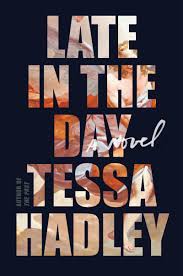 This weekend I got lost in Tessa Hadley’s brilliant new novel, Late in the Day. When I put it down to do housework I was unusually absent-minded. I flooded the dining-room table with teak oil as I pondered the relationships between the characters. If you know Hadley’s work you won’t be surprised, and if you don’t, Late in the Day is the perfect place to start.
This weekend I got lost in Tessa Hadley’s brilliant new novel, Late in the Day. When I put it down to do housework I was unusually absent-minded. I flooded the dining-room table with teak oil as I pondered the relationships between the characters. If you know Hadley’s work you won’t be surprised, and if you don’t, Late in the Day is the perfect place to start.
This insightful, delicate novel is about four close friends in their fifties. It begins with a phone call. Christine and her husband Alex are listening to classical music in their London apartment when the landline rings. Christine answers, expecting to hear her mother or daughter. But it is Lydia, her best friend since childhood, calling to say her husband Zachary has died of a heart attack. And this is traumatic for all of them, since Alex and Zachary, both sons of immigrants, grew up together and were lifelong best friends. The two couples are very close. And their adult daughters, too, grew up together and are close friends.
Relationships are complicated, as you might expect. Are there too many pairs of best friends? Perhaps I liked it because it is so unlikely, and yet I didn’t doubt it for a minute. It’s all a bit incestuous, like something out of early Margaret Drabble. And the eroticism and sentence cadences are reminiscent of D. H. Lawrence. It’s The Waterfall meets Women in Love, for the middle-aged. It’s beautifully written, and it is also a page-turner.
Hadley goes back and forth in time to tell their stories. She is a master of this kind of storytelling—she also does this in her superb novel The Past. The characters in Late in the Day are much more sophisticated than anyone I know, but she makes us understand how they became these people.
In their twenties, Christine, a graduate student in English, and Lydia, a dilettante and femme fatale, met Alex at the university. He was their French teacher and a poet, and Lydia developed a crush on him. She was so obsessed with Alex that she more or less stalked him. She got to know his wife, babysat for their child, and hung out at the bar where Alex goes. She dragged Christine along for credibility, so she wouldn’t look like a girl with a crush. But it doesn’t quite work out. Christine is impatient with Lydia’s obsession, and moody Alex has no sexual interest in Lydia. Anyway, Christine marries Alex (after he leaves his first wife) and Lydia marries Zachary. And they are happy, and their lives interwoven.
Their professional lives are also fascinating. Christine gives up working on a Ph.D. on Christina Rossetti to become an artist. Alex stops teaching as an adjunct at universities and becomes an elementary school teacher. Zachary, by far the kindest, most charming character in the book, opens his own gallery in a church and displays Christine’s work. And Lydia slouches around being gorgeous without actually doing anything. For me, Lydia is the problem–and yet I do know women like that!
Like Drabble, Hadley gives us lots of background on her complicated characters. Let me just say that their relationships become entangled after Zachary’s death. It will make you glad you’re unsophisticated, and at the same time you want to know these people.
